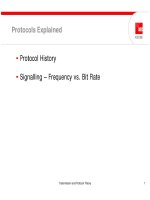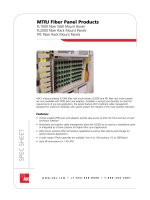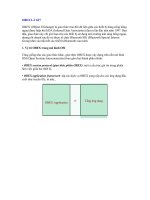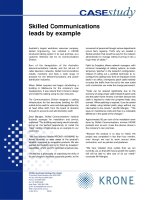Tài liệu Linux IO Port Programming pptx
Bạn đang xem bản rút gọn của tài liệu. Xem và tải ngay bản đầy đủ của tài liệu tại đây (47.13 KB, 13 trang )
Linux I/O port programming mini−HOWTO
Table of Contents
Linux I/O port programming mini−HOWTO.................................................................................................1
Author: Riku Saikkonen <>...............................................................................1
1. Introduction .........................................................................................................................................1
2. Using I/O ports in C programs.............................................................................................................1
3. Interrupts (IRQs) and DMA access......................................................................................................1
4. High−resolution timing........................................................................................................................1
5. Other programming languages.............................................................................................................1
6. Some useful ports.................................................................................................................................1
7. Hints.....................................................................................................................................................1
8. Troubleshooting...................................................................................................................................1
9. Example code.......................................................................................................................................1
10. Credits................................................................................................................................................1
1. Introduction .........................................................................................................................................2
2. Using I/O ports in C programs.............................................................................................................2
2.1 The normal method............................................................................................................................2
Permissions.................................................................................................................................2
Accessing the ports.....................................................................................................................3
2.2 An alternate method: /dev/port..........................................................................................................3
3. Interrupts (IRQs) and DMA access......................................................................................................3
4. High−resolution timing........................................................................................................................4
4.1 Delays................................................................................................................................................4
Sleeping: sleep() and usleep().....................................................................................................4
nanosleep()..................................................................................................................................4
Delaying with port I/O................................................................................................................4
Delaying with assembler instructions.........................................................................................5
rdtsc for Pentiums.......................................................................................................................5
4.2 Measuring time..................................................................................................................................6
5. Other programming languages.............................................................................................................6
6. Some useful ports.................................................................................................................................6
6.1 The parallel port.................................................................................................................................6
6.2 The game (joystick) port....................................................................................................................8
6.3 The serial port....................................................................................................................................9
7. Hints.....................................................................................................................................................9
8. Troubleshooting...................................................................................................................................9
9. Example code.....................................................................................................................................10
10. Credits..............................................................................................................................................11
Linux I/O port programming mini−HOWTO
i
Linux I/O port programming mini−HOWTO
Author: Riku Saikkonen <>
v3.0, 2000−12−13
This HOWTO document describes programming hardware I/O ports and waiting for small periods of time in
user−mode Linux programs running on the Intel x86 architecture.
1. Introduction
2. Using I/O ports in C programs
• 2.1 The normal method
• 2.2 An alternate method: /dev/port
3. Interrupts (IRQs) and DMA access
4. High−resolution timing
• 4.1 Delays
• 4.2 Measuring time
5. Other programming languages
6. Some useful ports
• 6.1 The parallel port
• 6.2 The game (joystick) port
• 6.3 The serial port
7. Hints
8. Troubleshooting
9. Example code
10. Credits
Linux I/O port programming mini−HOWTO 1
1. Introduction
This HOWTO document describes programming hardware I/O ports and waiting for small periods of time in
user−mode Linux programs running on the Intel x86 architecture. This document is a descendant of the very
small IO−Port mini−HOWTO by the same author.
This document is Copyright 1995−2000 Riku Saikkonen. See the Linux HOWTO copyright for details.
If you have corrections or something to add, feel free to e−mail me ()...
2. Using I/O ports in C programs
2.1 The normal method
Routines for accessing I/O ports are in /usr/include/asm/io.h (or
linux/include/asm−i386/io.h in the kernel source distribution). The routines there are inline
macros, so it is enough to #include <asm/io.h>; you do not need any additional libraries.
Because of a limitation in gcc (present in all versions I know of, including egcs), you have to compile any
source code that uses these routines with optimisation turned on (gcc −O1 or higher), or alternatively use
#define extern static before you #include <asm/io.h> (remember to #undef
externafterwards).
For debugging, you can use gcc −g −O (at least with modern versions of gcc), though optimisation can
sometimes make the debugger behave a bit strangely. If this bothers you, put the routines that use I/O port
access in a separate source file and compile only that with optimisation turned on.
Permissions
Before you access any ports, you must give your program permission to do so. This is done by calling the
ioperm() function (declared in unistd.h, and defined in the kernel) somewhere near the start of your
program (before any I/O port accesses). The syntax is ioperm(from, num, turn_on), where from is
the first port number to give access to, and num the number of consecutive ports to give access to. For
example, ioperm(0x300, 5, 1) would give access to ports 0x300 through 0x304 (a total of 5 ports).
The last argument is a Boolean value specifying whether to give access to the program to the ports (true (1))
or to remove access (false (0)). You can call ioperm() multiple times to enable multiple non−consecutive
ports. See the ioperm(2) manual page for details on the syntax.
The ioperm() call requires your program to have root privileges; thus you need to either run it as the root
user, or make it setuid root. You can drop the root privileges after you have called ioperm() to enable the
ports you want to use. You are not required to explicitly drop your port access privileges with
ioperm(..., 0) at the end of your program; this is done automatically as the process exits.
A setuid() to a non−root user does not disable the port access granted by ioperm(), but a
fork() does (the child process does not get access, but the parent retains it).
ioperm() can only give access to ports 0x000 through 0x3ff; for higher ports, you need to use
iopl() (which gives you access to all ports at once). Use the level argument 3 (i.e., iopl(3)) to give your
Linux I/O port programming mini−HOWTO
1. Introduction 2
program access to all I/O ports (so be careful −−− accessing the wrong ports can do all sorts of nasty things
to your computer). Again, you need root privileges to call iopl(). See the iopl(2) manual page for
details.
Accessing the ports
To input a byte (8 bits) from a port, call inb(port), it returns the byte it got. To output a byte, call
outb(value, port) (please note the order of the parameters). To input a word (16 bits) from ports
x and x+1 (one byte from each to form the word, using the assembler instruction inw), call inw(x). To
output a word to the two ports, use outw(value, x). If you're unsure of which port instructions (byte or
word) to use, you probably want inb() and outb() −−− most devices are designed for bytewise port
access. Note that all port access instructions take at least about a microsecond to execute.
The inb_p(), outb_p(), inw_p(), and outw_p() macros work otherwise identically to the ones
above, but they do an additional short (about one microsecond) delay after the port access; you can make the
delay about four microseconds with #define REALLY_SLOW_IO before you #include
<asm/io.h>. These macros normally (unless you #define SLOW_IO_BY_JUMPING, which is
probably less accurate) use a port output to port 0x80 for their delay, so you need to give access to port 0x80
with ioperm() first (outputs to port 0x80 should not affect any part of the system). For more versatile
methods of delaying, read on.
There are manual pages for ioperm(2), iopl(2), and the above macros in reasonably recent releases of
the Linux manual page collection.
2.2 An alternate method: /dev/port
Another way to access I/O ports is to open() /dev/port (a character device, major number 1, minor 4)
for reading and/or writing (the stdio f*() functions have internal buffering, so avoid them). Then
lseek() to the appropriate byte in the file (file position 0 = port 0x00, file position 1 = port 0x01, and so
on), and read() or write() a byte or word from or to it.
Naturally, for this to work your program needs read/write access to /dev/port. This method is probably
slower than the normal method above, but does not need compiler optimisation nor ioperm(). It doesn't
need root access either, if you give a non−root user or group access to /dev/port −−− but this is a very
bad thing to do in terms of system security, since it is possible to hurt the system, perhaps even gain root
access, by using /dev/port to access hard disks, network cards, etc. directly.
You cannot use select(2) or poll(2) to read /dev/port, because the hardware does not have a facility
for notifying the CPU when a value in an input port changes.
3. Interrupts (IRQs) and DMA access
You cannot use IRQs or DMA directly from a user−mode process. You need to write a kernel driver; see The
Linux Kernel Hacker's Guide for details and the kernel source code for examples.
You can disable interrupts from within a user−mode program, though it can be dangerous (even kernel
drivers do it for as short a time as possible). After calling iopl(3), you can disable interrupts simply by
calling asm("cli");, and re−enable them with asm("sti");.
Linux I/O port programming mini−HOWTO
Accessing the ports 3









